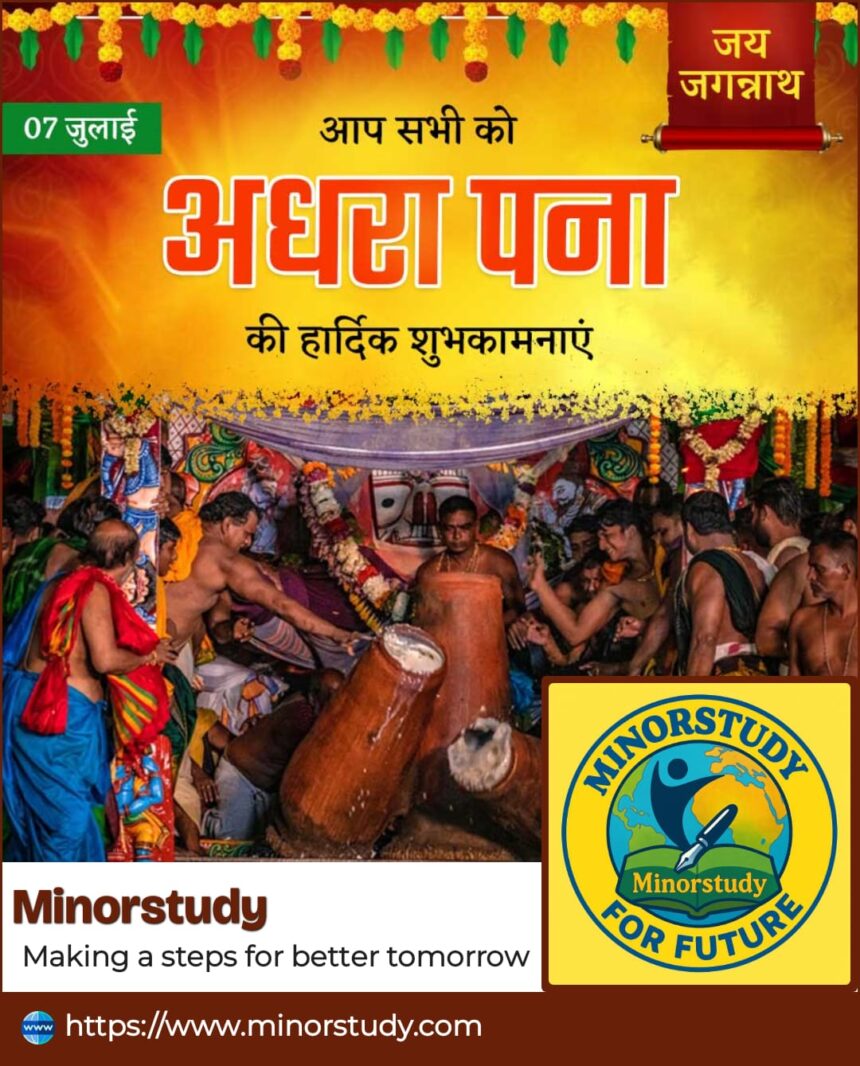🪔 Wishing You All a Very Happy Adhara Pana 🪔
May this sacred ritual bring purification, peace, and spiritual awakening in your life.
- 🌿 Introduction: What is Adhara Pana?
- 📜 History of Adhara Pana
- 🧠 7 Powerful Facts About Adhara Pana
- ⏳ Timeline of Adhara Pana
- 🌈 Significance of Adhara Pana in Our Lives
- 1. Spiritual Inclusiveness
- 2. Purification of the Environment
- 3. Ecological Wisdom
- 4. Message of Selfless Giving
- 5. Balancing the Spiritual Realms
- 🙋 Frequently Asked Questions (FAQs)
- Q1. Why is Adhara Pana not consumed by devotees?
- Q2. Is it true that breaking the pots is symbolic?
- Q3. Who prepares the pana?
- Q4. Can we replicate Adhara Pana at home?
- Q5. Is there a similar ritual in any other temple?
- 🌿 How It’s Observed: Step-by-Step Ritual
- ✨ Wishing on Adhara Pana
- 🎯 Important Points at a Glance
- 🧘♂️ Importance in Our Life and Society
- ✅ Conclusion: Daily Life Impact of Adhara Pana
🌿 Introduction: What is Adhara Pana?
Adhara Pana is an ancient and deeply spiritual ritual observed during the concluding ceremony of the Jagannath Rath Yatra in Puri, Odisha. Rooted in the Vaishnavite tradition, this unique ritual involves the offering of a sacred herbal drink to divine beings known as ‘guardian spirits’ or ‘invisible servitors’ of Lord Jagannath.
This tradition, though lesser known to the general public, holds immense importance in maintaining the spiritual and cosmic balance during the return journey of the deities back to their temple.
Let us explore the history, significance, facts, timeline, FAQs, and societal importance of Adhara Pana in a detailed, human-centric, and reader-friendly manner.
📜 History of Adhara Pana
The term Adhara Pana is derived from two Sanskrit words:
Adhara = Lip or base
Pana = Drink
According to the Skanda Purana and ritual texts of Odisha, this practice is believed to have originated in the 13th century. It has been observed in Puri for centuries and is considered a powerful act of spiritual hospitality, where beings of the astral realm are offered nourishment.
It takes place on the 11th day of the bright fortnight (Shukla Paksha) in the month of Ashadha, marking the final phase of Rath Yatra.
🧠 7 Powerful Facts About Adhara Pana
Conducted at Gundicha Temple: This is where Lord Jagannath, Balabhadra, and Subhadra stay during the Rath Yatra before returning to their abode.
Sacred Drink Recipe: The pana (drink) is made from banana, milk, chhena (cheese), sugar, ginger, black pepper, nutmeg, cardamom, and tulsi—all herbal and sattvic.
Served in Big Earthen Pots: The drink is filled in clay pots placed before the deities and is never consumed by humans.
Ritual Breaking: Once the deities symbolically sip the drink, the pots are broken so the spirit beings can consume it freely without restriction.
Ritual Purification: It is believed this act cleanses the environment of negative energies gathered during the Rath Yatra.
Dedicated to Non-visible Beings: These include bhutas, pretas, and ganas—subtle beings who serve the Lord silently and spiritually.
Once-a-Year Ritual: Adhara Pana is observed only once a year, making it sacred and unique among Indian rituals.
⏳ Timeline of Adhara Pana
| Date | Event |
|---|---|
| Day 1 (Rath Yatra begins) | Lord Jagannath, Balabhadra, and Subhadra leave Srimandir for Gundicha Temple. |
| Day 9 | Bahuda Yatra – the return journey begins. |
| Day 10 | Suna Besha – Deities are decorated in golden attire. |
| Day 11 | Adhara Pana Ritual – Herbal drink is offered to invisible spirits. |
| Day 12 | Niladri Bije – Return of the deities to Srimandir. |
🌈 Significance of Adhara Pana in Our Lives
1. Spiritual Inclusiveness
Adhara Pana is a gesture of cosmic inclusiveness. It acknowledges that not all who serve God are visible to the eye, reflecting humility and spiritual awareness.
2. Purification of the Environment
The sacred ingredients in the pana have antibacterial and energizing properties. Symbolically, they cleanse negative energies absorbed during the public event of Rath Yatra.
3. Ecological Wisdom
The ritual uses biodegradable clay pots, reminding us to respect Mother Earth and choose eco-friendly practices in religious ceremonies.
4. Message of Selfless Giving
Since humans do not consume the pana, it teaches us the value of selfless service and offerings without expectation, a vital principle in Sanatan Dharma.
5. Balancing the Spiritual Realms
It acts as a ritual closure to the energetic disruptions that happen during massive festivals, restoring spiritual balance and order.
🙋 Frequently Asked Questions (FAQs)
Q1. Why is Adhara Pana not consumed by devotees?
Because it is strictly meant for non-human spirits who assist during the Rath Yatra. Consuming it would be spiritually inappropriate.
Q2. Is it true that breaking the pots is symbolic?
Yes. The breaking of pots symbolizes freedom for the spirits to drink without restriction—signifying liberation and gratitude.
Q3. Who prepares the pana?
The Suaras (temple cooks) prepare the pana under strict ritualistic procedures using satvik ingredients.
Q4. Can we replicate Adhara Pana at home?
While the drink can be made for personal health benefits, the ritual of Adhara Pana is unique to Jagannath culture and must be respected as such.
Q5. Is there a similar ritual in any other temple?
Not quite. Adhara Pana is unique to Puri’s Jagannath culture, showcasing the exclusivity and depth of the tradition.
🌿 How It’s Observed: Step-by-Step Ritual
Preparation of Pana: Made using milk, banana, chhena, and over 10 spiritual herbs.
Offering by Servitors: Pana is offered in front of the deities at Gundicha Temple.
Symbolic Sipping by Deities: Through spiritual invocation, the deities symbolically accept the offering.
Breaking of Pots: With reverence, the pots are broken on the ground.
Completion of Ritual: The area is cleaned, and blessings are sought for universal well-being.
✨ Wishing on Adhara Pana
🌟 “On this sacred day of Adhara Pana, may your life be filled with purity, humility, and divine grace. May the silent spirits bless your soul with peace and protection. Jai Jagannath!” 🌟
You can wish others like:
“Wishing you peace and purity on this blessed Adhara Pana day.”
“Let us honour the unseen helpers of the divine. Happy Adhara Pana!”
“May Lord Jagannath bless you with the wisdom of selfless giving this Adhara Pana.”
🎯 Important Points at a Glance
Observed during Jagannath Rath Yatra.
Pana offered to invisible servitors of the Lord.
Ritual involves breaking the clay pots after offering.
Ingredients are Ayurvedic and pure.
Represents spiritual inclusiveness and gratitude.
Not consumed by humans—purely ritualistic.
Helps restore balance post the grand Yatra.
🧘♂️ Importance in Our Life and Society
Personal Life:
Encourages humility: Teaches us that not all contributions are visible.
Builds a deeper spiritual mindset rooted in respect for the unseen.
Enhances ecological sensitivity through its use of sustainable materials.
Societal Impact:
Protects ancient traditions and promotes intergenerational knowledge.
Encourages community participation with reverence.
Serves as a reminder to honour unsung heroes—a lesson relevant in all spheres, from families to workplaces.
✅ Conclusion: Daily Life Impact of Adhara Pana
Though Adhara Pana is an annual ritual, its lessons transcend the calendar:
Be grateful to those whose contributions remain unseen.
Practice selfless giving, expecting nothing in return.
Respect and protect your environment through conscious choices.
Honour ancient wisdom that brings cosmic and ecological balance.
In a world driven by visibility and validation, Adhara Pana reminds us of the silent hands that shape our lives. Let this sacred observance be a mirror to our deeper values.
🌿 Happy Adhara Pana! 🌿
Let us bow not only to the divine but also to those who serve it in silence.








